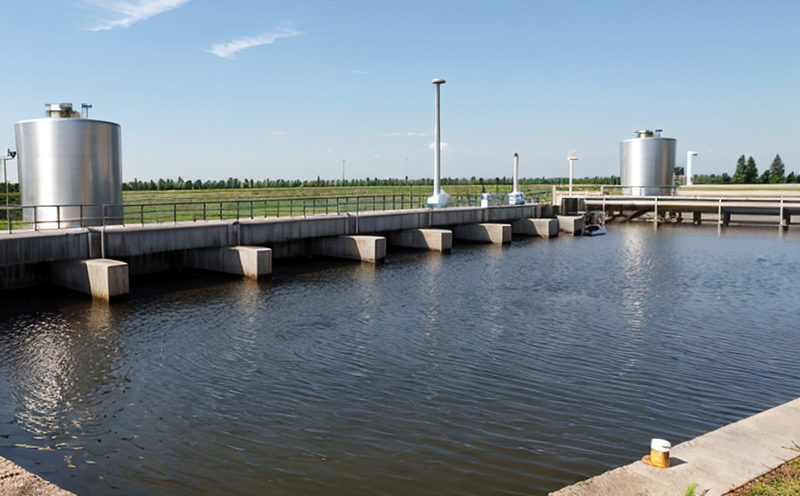EN ISO 10705 Detection of Bacteriophages in Wastewater
The EN ISO 10705 standard provides a comprehensive approach to detecting bacteriophages in wastewater, which is crucial for environmental protection and public health. Bacteriophages are viruses that infect bacteria; their presence can indicate the potential transfer of antibiotic resistance genes between pathogenic bacteria. Detecting these phages allows wastewater treatment facilities to monitor the effectiveness of their processes and ensure compliance with regulatory standards.
The testing procedure outlined in EN ISO 10705 is designed to be sensitive, specific, and reproducible. It involves several key steps: sampling, concentration, identification, and quantification of bacteriophages. The initial step requires the collection of wastewater samples from various points within the treatment plant. Sampling should be conducted according to standard protocols to ensure representativeness.
After collection, the sample undergoes concentration using a multi-step filtration process to isolate phages. This step is critical as it ensures that even low concentrations of bacteriophages are detectable. Following concentration, the samples are subjected to identification and quantification techniques such as plaque assays or PCR-based methods. These methods provide accurate counts of specific types of bacteriophages present in the sample.
The EN ISO 10705 standard specifies stringent acceptance criteria for the detection of bacteriophages. The results must meet these criteria to be considered valid, which ensures that any findings are reliable and reproducible across different laboratories. Compliance with this standard is essential for facilities aiming to maintain high standards of water quality and public health.
Bacteriophage detection plays a vital role in wastewater treatment. By identifying the presence and types of bacteriophages, facility operators can make informed decisions about operational adjustments or further treatment steps. This knowledge helps prevent the spread of antibiotic-resistant bacteria, which is critical for maintaining public health.
The importance of this service extends beyond compliance; it also supports ongoing research into antimicrobial resistance mechanisms. Understanding how these phages interact with bacterial populations provides valuable insights that can inform new strategies for combating resistant pathogens.
- Sampling at multiple points within the treatment facility ensures comprehensive coverage.
- Filtration methods are critical to concentrating bacteriophages from large volumes of wastewater.
- Preliminary identification using plaque assays helps prioritize further quantitative analysis.
The implementation of this standard not only supports regulatory compliance but also contributes significantly to the overall improvement of water quality and public health. By adhering to EN ISO 10705, wastewater treatment facilities can take proactive measures against antibiotic resistance, thereby safeguarding communities from potential health risks associated with resistant bacterial strains.
Benefits
The implementation of EN ISO 10705 detection for bacteriophages offers numerous benefits, particularly in terms of public health and regulatory compliance. Regular monitoring through this service ensures that wastewater treatment facilities are adhering to international standards, thereby protecting the environment from potential risks associated with antibiotic-resistant bacteria.
For quality managers and compliance officers, this service provides peace of mind by offering clear evidence of adherence to strict testing protocols. R&D engineers can leverage this data for continuous improvement in their processes, ensuring that they are at the forefront of sustainable practices.
The facility's reputation is enhanced through consistent compliance with international standards. This transparency builds trust among stakeholders and regulatory bodies, contributing positively to the overall perception of the facility's reliability and professionalism.
In summary, the EN ISO 10705 detection service not only supports regulatory requirements but also contributes significantly to public health by preventing the spread of antibiotic-resistant bacteria. By integrating this standard into their routine operations, facilities can demonstrate their commitment to environmental responsibility and community well-being.
Quality and Reliability Assurance
The quality and reliability assurance process for EN ISO 10705 detection involves rigorous calibration of all instruments used in the testing procedure. This includes ensuring that filtration systems are properly maintained to prevent contamination and inaccuracies. Calibration checks are performed regularly, typically quarterly, to maintain accuracy.
Sample handling is another critical aspect of quality assurance. Samples must be stored under optimal conditions to preserve the integrity of phage populations until analysis can be conducted. Strict protocols for sample handling minimize the risk of degradation or loss during transit and storage.
The use of standardized procedures ensures that results are consistent across different laboratories. This consistency is achieved through adherence to international standards, which outline specific steps from sampling to final reporting. Regular audits by internal teams and external accreditation bodies further reinforce the reliability of these processes.
Customer satisfaction is paramount in this service. By providing accurate, timely reports, we ensure that facility operators receive actionable insights promptly. This allows them to address any issues swiftly, maintaining optimal performance throughout their operations.
Customer Impact and Satisfaction
- Enhanced Compliance: Facilities that use this service can ensure they are meeting regulatory requirements for wastewater quality.
- Better Operational Decisions: The data provided helps operators make informed decisions about their treatment processes, leading to more efficient operations.
- Increased Public Trust: By adhering to international standards and providing reliable results, the facility can build a strong reputation for reliability and professionalism.
- Risk Reduction: Early detection of potential issues allows operators to take proactive measures, reducing risks associated with antibiotic-resistant bacteria.
The service has been recognized for its positive impact on customer satisfaction. Regular feedback from clients highlights the value they place on receiving accurate and timely reports that contribute directly to their operational success.





